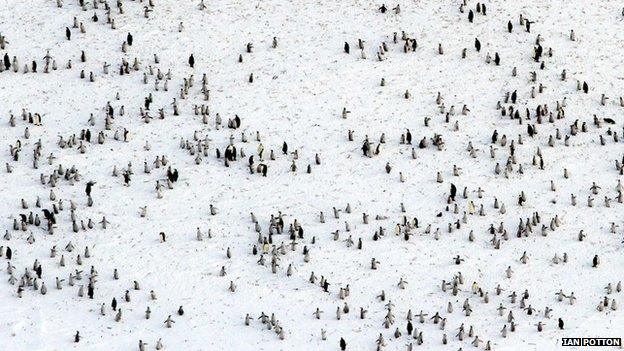Emperor penguins beat ice cliffs to breed
- Published

The emperor is the only Antarctic species to breed on sea ice in the winter
Emperor penguins have displayed some unexpected breeding behaviour in the Antarctic that could mean they are much more resilient to environmental change than previously recognised.
Satellite images show colonies moving their locations in years when the thin sea ice on which they habitually breed forms late or is absent.
Scientists report the observations in the online journal Plos One.
They reveal the birds travelling long distances to find alternative sites.
These are further in towards the coast, up on the ice shelves - the thick slabs of glacier ice that jut out over the ocean.
It is a surprise because these shelves are frequently faced with cliffs that may be tens of metres high in places. But somehow, the emperors find a way up to breed, and also to come and go as they forage for the seafood that will sustain their chicks.
"We thought that in years when the sea ice was bad, they just didn't breed, but they're clearly more adaptable than that," said lead author Peter Fretwell from the British Antarctic Survey.
The emperor is the most southerly of the Antarctic penguin species and the only one to breed on sea ice in the southern winter.
Their reliance on these thin seasonal marine floes as a reproductive platform, coupled with concern about how the patterns of Antarctic sea ice could change in a warming world, has led to the species being designated as "near threatened" on the IUCN red list.
Currently, the extent of winter sea ice in the Antarctic is growing year by year, albeit slowly.
The coverage does however vary considerably by region, and climate computer models indicate any gains will very likely be reversed later this century.
But this study on four colonies around the continent suggests emperors do have the capacity to meet and beat some of the challenges that may lie ahead.
In the observations of Shackleton Ice Shelf in East Antarctica, for example, the penguins are seen to be very adept at finding the routes that allow them to get past a 30m-high cliff.
"When they go out from the colony to forage, they go down the steep cliff - the shortest route to the sea. We're not sure how they get down - they may slide down or jump down," Mr Fretwell told BBC News.
"But this cliff is too steep for them to climb back up and so they must return a different way, likely through an ice creek. This route is 5km longer and we know they take it because we can see their tracks in the satellite pictures."
There is a big opportunity here to go study these penguins which have yet to be visited by an expedition.
There is obviously some cost to going up on the ice shelves - they are windier and the birds must travel further to forage. If that cost was not there, they would habitually breed on the shelves rather than the temperamental thin floes. But how big this cost is and how beneficial is the observed adaptation in years of poor sea ice has yet to be properly established.
Co-author Barbara Wienecke from the Australian Antarctic Division said: "These new findings are an important step forward in helping us understand what the future may hold for these animals. However, we cannot assume that this behaviour is widespread in other penguin populations.
"The ability of these four colonies to relocate to a different environment - from sea ice to ice shelf - in order to cope with local circumstances, was totally unexpected.
"We have yet to discover whether or not other species may also be adapting to changing environmental conditions."

With some 50 emperor colonies in the Antarctic, not all have been visited by an expedition

The research shows the penguins have the ability to find a suitable route up on to the ice shelves
Jonathan.Amos-INTERNET@bbc.co.uk and follow me on Twitter: @BBCAmos, external
- Published22 August 2013
- Published13 April 2012
- Published2 June 2011